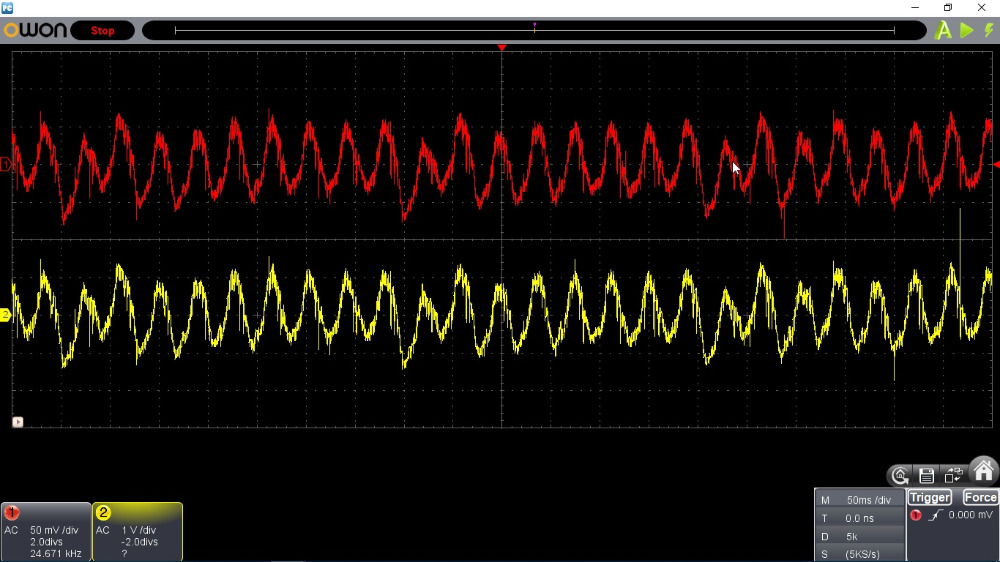A place to discuss hardware/software and diagnostic procedures
Attenuators!
4 years 8 months ago #32484
by Wood
Attenuators! was created by Wood
Can someone explain to me how you choose which attenuator to use? If you're not sure what the voltage spike is going to be on an ignition system do you just go with a 20:1? instead of buying both can I just get away with always using a 20:1? What's the drawback...less detail?
Please Log in or Create an account to join the conversation.
- Andy.MacFadyen
-

- Offline
- Moderator
-

Less
More
- Posts: 3353
- Thank you received: 1031
4 years 8 months ago - 4 years 8 months ago #32490
by Andy.MacFadyen
" We're trying to plug a hole in the universe, what are you doing ?. "
(Walter Bishop Fringe TV show)
Replied by Andy.MacFadyen on topic Attenuators!
X20 is pretty much the standard for automotive work, the loss of resolution compared to an X10 isn't a major issue. I have even tried X100 and still got useful captures.
" We're trying to plug a hole in the universe, what are you doing ?. "
(Walter Bishop Fringe TV show)
Last edit: 4 years 8 months ago by Andy.MacFadyen.
Please Log in or Create an account to join the conversation.
- Andy.MacFadyen
-

- Offline
- Moderator
-

Less
More
- Posts: 3353
- Thank you received: 1031
4 years 8 months ago #32498
by Andy.MacFadyen
" We're trying to plug a hole in the universe, what are you doing ?. "
(Walter Bishop Fringe TV show)
Replied by Andy.MacFadyen on topic Attenuators!
Exploring this topic with a few test demos might be an idea next time I look at injector I will do some captures
" We're trying to plug a hole in the universe, what are you doing ?. "
(Walter Bishop Fringe TV show)
Please Log in or Create an account to join the conversation.
4 years 8 months ago #32499
by Chad
"Knowledge is a weapon. Arm yourself, well, before going to do battle."
"Understanding a question is half an answer."
I have learned more by being wrong, than I have by being right.
Replied by Chad on topic Attenuators!
It, really, depends on your scope. An Ignition coil control can spike up to 400 volts. Snap-on Scopes can handle a voltage spike of 400 volts, so no attenuator is needed. The Picoscope 4425 has a 200 volt limit, so a 10:1 attenuator is plenty.
"Knowledge is a weapon. Arm yourself, well, before going to do battle."
"Understanding a question is half an answer."
I have learned more by being wrong, than I have by being right.
Please Log in or Create an account to join the conversation.
- Andy.MacFadyen
-

- Offline
- Moderator
-

Less
More
- Posts: 3353
- Thank you received: 1031
4 years 8 months ago - 4 years 8 months ago #32505
by Andy.MacFadyen
" We're trying to plug a hole in the universe, what are you doing ?. "
(Walter Bishop Fringe TV show)
Replied by Andy.MacFadyen on topic Attenuators!
Some times a result can be a surprise --- the simplest test was alternator ripple I used the cheap and cheerful Owon VDS1022I
I offer no explanation but they are identical --- might be different with a fast 12 bit Pico
Channel 1 Red with x20 Attenuator
Channel 2 Yellow plain jane 1:1 test lead
I offer no explanation but they are identical --- might be different with a fast 12 bit Pico
Channel 1 Red with x20 Attenuator
Channel 2 Yellow plain jane 1:1 test lead
" We're trying to plug a hole in the universe, what are you doing ?. "
(Walter Bishop Fringe TV show)
Last edit: 4 years 8 months ago by Andy.MacFadyen.
The following user(s) said Thank You: Noah
Please Log in or Create an account to join the conversation.
4 years 8 months ago #32814
by Wood
Replied by Wood on topic Attenuators!
This forum never ceases to amaze me. Thank you guys for the information and support. I never heard of owon before. I bought a u-scope to start out with and I've been looking at the hantek, but this owon looks like it might be a good starter scope as well. I noticed the max voltage on the owon is 400 volts. How exactly does the ratio work for an attenuator? A 20:1 will protect your device at 20 times the amount of rated voltage? So max input voltage is 400...with a 20:1 attenuator you're protected up to 8,000 volts (400×20)?
The following user(s) said Thank You: Tyler
Please Log in or Create an account to join the conversation.
- Andy.MacFadyen
-

- Offline
- Moderator
-

Less
More
- Posts: 3353
- Thank you received: 1031
4 years 8 months ago #32828
by Andy.MacFadyen
" We're trying to plug a hole in the universe, what are you doing ?. "
(Walter Bishop Fringe TV show)
Replied by Andy.MacFadyen on topic Attenuators!
400v is the isolation voltage that is the voltage the scope can experience without zapping your PC. With a a 1x probe you can have a 50v dc screen I checked this by measuring the peak voltage put out by 24v booster battery charger which puts out a whacking 42v peak !!!! I am pretty sure the scope would survive direct to a normal gasoline fuel.injector but I would want an attenuator for a coil primary or diesel. Injector or piezo injector.
" We're trying to plug a hole in the universe, what are you doing ?. "
(Walter Bishop Fringe TV show)
Please Log in or Create an account to join the conversation.
Time to create page: 0.200 seconds


